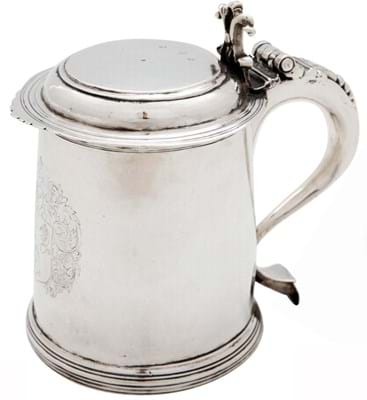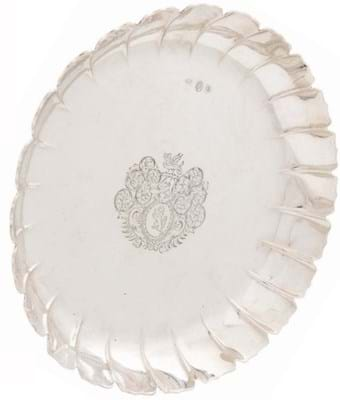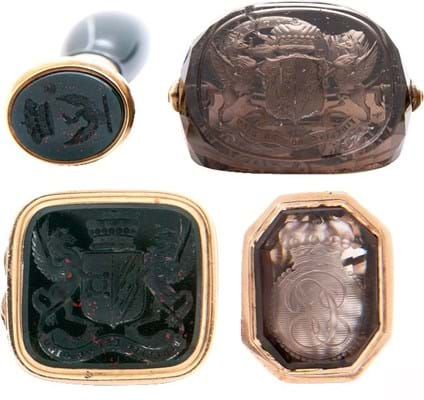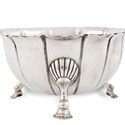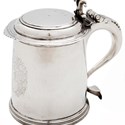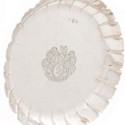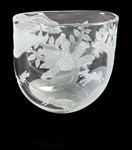Sometimes titles of sales are enough to quicken the pulse of collectors – Silver From The Collection of Jimmy Weldon offered at Dublin auction house Adam’s (20% buyer’s premium) on May 16 being a good example.
After more than 50 years at the shop in Dublin’s Clarendon Street established by his grandfather in the 1890s, and becoming a respected sage in the process, Weldon is handing over the reins to the fourth generation, his son Gareth.
In fact, Weldon Snr, like all dealers, is not really even retiring. He still intends to meet and advise old clients which, more and more, is a dealer’s lot as passing trade becomes a thing of the past.
Fellow dealers tend to be reluctant to bid on what they regard as trade pieces – and indeed there was some truth in the belief that Weldon was refining his collection rather than putting all his best acquisitions on the market.
However, it was enough to inspire private collectors from the USA to Hong Kong via Continental Europe to vie with Irish collectors.
Of the 182 lots, which ranged from three to five-figure bids, 88% got away to a total of €305,500 (£267,280).
Capital consignment
Dublin silver dominated the day, led by a 1715 strawberry dish by John Hamilton. The 8½in (22cm) diameter, 12oz dish with 24 panels and a central armorial was estimated at €5000-8000 and went at €13,500 (£11,810) to a bidder described by auctioneer Stuart Cole as “an international collector”.
Other early Dublin silver to go well above estimates included a plain bowl on a short pedestal foot by Edward Workman, 1724. The 6½in (17cm) diameter, 17oz bowl went to a collector at €12,500 (£10,940).
Irish collectors were out in force and one took a 17th century offering – a 7½in (19cm) tall, lidded tankard by Joseph Walker, Dublin 1696, engraved with an armorial, probably for the Minnit family of Tipperary. The 31oz tankard was estimated at €7000-9000 and sold at €12,000 (£10,500).
This was not one of those sales where a dealer was reluctant to sell at anything below retail value, but by no means everything went above estimate. “Jimmy was keen that pieces should sell and gave us a fair amount of discretion if bidding stopped a bit short of the reserve,” said Cole.
One such case was an imposing two-handled tray by Robert Smith, Dublin, 1844.
The 2ft 8in (80cm) wide oval tray on four large scrolled feet weighed 230oz and was chased with marine subjects: seaweed, shells, fish and a central Neptune mask. Estimated at €10,000-15,000, it sold to the UK trade at €9300 (£6800).
While Dublin smiths dominated the silver trade in terms of output, fine pieces were produced elsewhere, particularly Cork.
Nevertheless, after the city’s Mayor, Sheriffs and Common Council voted to grant the freedom of the city to an admiral in 1825 it was Dublin which supplied the traditional freedom box.
The 2 x 3in (5.5 x 7.5cm) gilt-lined, heavily engraved box was inscribed with the city’s coat of arms, signatures of the councillors and name of the recipient. It also carried the mark of Richard Garde, Dublin 1821, and was possibly an earlier, unused purchase.
Rarer than Dublin, Cork silver does command a small premium. Estimated at €4000- 6000, the 3.5oz box sold at €6700 (£5860).
A slightly larger Cork City freedom box engraved to the Honble. Geoe. Ponsonby Representative in Parliament for the County of Cork took a top-estimate €8000 (£7000). It was made c.1807 by the respected Cork smiths Carden Terry and Jane Williams.
Another Cork piece was a 16½in (42cm) diameter shaped salver by John Nicholson c.1775. With a raised beaded rim interspersed by small shells and a central armorial reserve, the 50oz tray salver went above hopes at €7500 (£6560).
Provincial rarities
Rarer still are the pieces from other provincial centres. Two examples at Adam’s were a c.1750 Limerick sugar bowl and a c.1712 Kinsale spoon.
The 5in (12.5cm) diameter, 6oz circular bowl was marked for the Limerick goldsmith Collins Brehon. Estimated at €8000-12,000, it sold at €13,000 (£11,370) to the big-spending international collector who bought the Dublin strawberry dish.
The extremely rare trefid spoon was marked for William and/or Joseph Wall.
Material by the Walls have appeared on these pages in the past, and both names are known from the records of the Dublin Goldsmiths’ Company referring to plate sent by the Walls to Dublin to be assayed. However, information about them, even as to their relationship, is sketchy.
They were the subject of one of the small monographs Weldon (himself twice a Master Warden of the Worshipful Company of Goldsmiths) wrote alongside some of the lots in the Adam’s catalogue.
The 7½in (19cm) long, 1.5oz spoon was initialled to the reverse of the terminal DRM 1733, presumably for the then owner. In the Dublin sale it went to an Irish collector at €11,000 (£9600), just under top estimate.
Topping the Weldon consignment was a set of four mid-19th century gold-mounted seals commissioned by or for the 7th Viscount Powerscourt.
Variously featuring smoky quartz or bloodstones, all bore aspects of the viscount’s coat of arms, crest, coronet and motto.
Estimated at €8000-12,000, the quartet went at €15,000 (£13,120) to the international buyer who also bought the top-selling Dublin strawberry dish and Limerick sugar bowl.
£1 = €1.15



